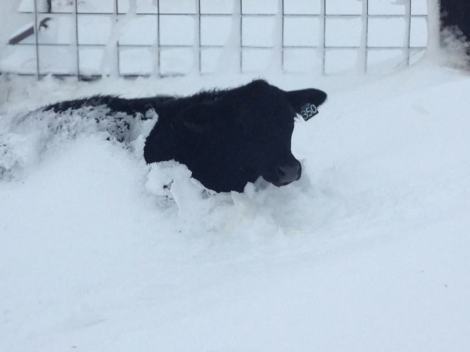
Dean Wink
Ranchers are finding carcasses everywhere, often clustered together at a fence line, emerging from the melting snow. Nobody knows how many cattle were killed in the blizzard that hit South Dakota and Wyoming on Oct. 4; the actual number probably won’t be tallied until spring. But it could be hundreds of thousands, the Wall Street Journal reports:
South Dakota Secretary of Agriculture Lucas Lentsch, citing estimates from industry groups, said as much as 5% of the state’s 3.85 million cattle may have been killed, though he said the total death count may not be known until the spring.
As cow catastrophes go, that’s a big deal. Nothing this severe has happened in recent memory. But it’s not just about money; it’s also an emotional blow for many ranchers. Dawn Wink blogged about the raw feelings evident in her parents’ communications from their ranch:
Mom texted me after the storm. “No electricity. Saving power on phone. It’s really, really bad….” She turned on her phone to call me later that day. “There are no words to describe the devastation and loss. Everywhere we look there are dead cattle. I’ve never seen so many dead cattle. Nobody can remember anything like this.” … “I can’t imagine writing about this. I’m not going to take photos. These deaths are too gruesome. Nobody wants to see this.”

Joan Wink
This blizzard caused so much havoc because it arrived bizarrely early, the Rapid City Journal reports:
[Silvia Christen, executive director of the South Dakota Stockgrowers Association] said cattle hadn’t yet grown their winter coats to insulate them from freezing wind and snow.
In addition, Christen said, during the cold months, ranchers tend to move their cattle to pastures that have more trees and gullies to protect them from storms. Because Friday’s storm arrived so early in the year, most ranchers were still grazing their herds on summer pasture, which tend to be more exposed and located farther away from ranch homes.
There’s been a lot of harsh weather on the prairies in the past few seasons. After two years of drought, it had been looking like this was the year that ranching families were going to recover a bit. Instead, they are wondering if they’ll even get the modest government aid that usually comes in this type of situation, according to the Rapid City Journal.
Jodie Anderson, executive director of the South Dakota Cattlemen’s Association, said the pain for ranchers is now compounded by dysfunction within the federal government.
While the government has programs to help ranchers who suffer losses from catastrophic weather events, those programs are in limbo because Congress has failed to pass a farm bill. The legislation is normally passed every five years and controls subsidy and insurance programs for the agriculture industry.
Making things worse, because the government is currently in a partial shutdown, ranchers are unable to ask federal officials questions about how they might be reimbursed in the future.
One thing big government is good for is helping people back to their feet after hurricanes, or floods, or blizzards. It’s worth pointing out that the same people in the federal government who deny that human-driven climate change exists — or might be responsible for incidents of extreme weather — are the ones insisting that no government is better than big government.



